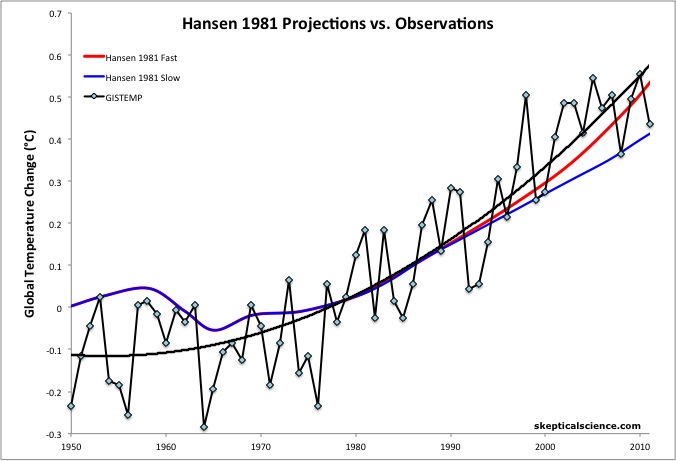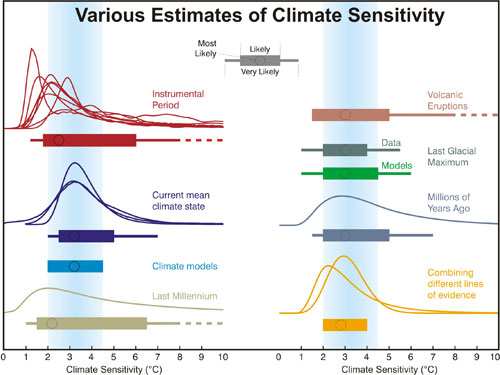
When it comes to global climate change, there are two critical and intertwined, but distinct issues: science, and policy. We generally focus on the science, because that is what dictates the appropriate policy response, or at least what our climate policy needs to accomplish.
Justin Gillis had an excellent article published in The New York Times this past week, which addresses both science and policy. The science aspect of the article bears some resemblance to one of our posts from a year ago, Climate Sensitivity: The Skeptic Endgame. The fundamental premise of both articles involves the fact that, because of the sound basic science supporting the human-caused global warming theory, there only remains one fallback position for the remaining relatively credible climate contrarians. That fallback position involves climate sensitivity being lower than the body of scientific evidence indicates.
Gillis' article focuses mainly on Richard Lindzen, who is one of the relatively more credible climate contrarians (although he has a long history of taking contrarian positions on nearly every climate-related issue, and being almost universally wrong on those issues). Lindzen embodies the low climate sensitivity fallback position perfectly, but as we will see here, the basis of Lindzen's argument, which itself is the basis of all remaining relatively credible climate contrarianism, is entirely false and undermined by three inescapable flaws.
We know that humans are rapidly increasing the level of CO2 and other greenhouse gases (GHGs) in the atmosphere, we know that this GHG increase is causing some amount of warming, and will continue to cause additional warming as long as GHG levels continue to rise. The remaining relatively credible climate contrarians like Lindzen acknowledge these realities; where they differ from mainstream climate science is in exactly how much warming the GHG increase will cause. This is known as the climate sensitivity - how much the planet will warm in response to increasing GHGs, including feedbacks.
For contrarians like Lindzen, climate sensitivity must be low, or they have no case to make. They have acknowledged that GHGs will cause warming, and their only argument against taking serious action to reduce GHG emissions is this premise that the GHG increase won't cause very much warming. That is why we described this argument as the 'skeptic' endgame, and Gillis accurately described it as the dissenters' "last bastion."
So what is Lindzen's case for low climate sensitivity? He summed it up in the recent ABC documentary discussed by John Cook, I Can Change Your Mind About Climate (see minute 21 in this video). In response to a comment that the average global surface temperature has warmed about three-quarters of a degree Celsius, Linzen responds:
"Yeah, and we should have seen 3[°C]"
This is a very brief encapsulation of Lindzen's pet argument, Earth hasn't warmed as much as expected. I call it his 'pet argument' because he makes it in virtually every talk and presentation he gives, and has been making it since at least 1989, despite the fact that it's been debunked time and time again (i.e. Skeptical Science alone has debunked it here and here and here and here and here and here).
In short, if climate sensitivity is lower than resulting in climate models, then the climate should have warmed less than climate models have predicted. In order to argue that this is the case, Lindzen claims that CO2-equivalent (the total radiative forcing for all greenhouse gases in units equivalent to CO2-caused warming) has already doubled from pre-industrial levels; therefore, if climate sensitivity is around 3°C for doubled CO2 (as in climate models), the planet should have warmed 3°C. It has not warmed nearly so much; therefore, Lindzen asserts, climate sensitivity is low.
The problem with Lindzen's argument for low sensitivity is that it contains three separate fundamental flaws:
By themselves, each of these fundamental errors completely invalidates Lindzen's argument. Taken together, they form a trio of Achilles' Heels which leave us puzzled as to how Lindzen has continued to make this obviously and grossly fundamentally flawed argument for over two decades.
In addition to these three glaring errors, we know the Earth has warmed as much as expected because climate scientists compare their model runs to observational data. We've done a whole series of posts looking at the accuracy of past climate model predictions, our most recent entry being Hansen et al. 1981 (Figure 1).
Figure 1: Hansen et al. (1981) global warming projections under a scenario of high energy growth (4% per year from 1980 to 2020) (red) and slow energy growth (2% per year from 1980 to 2020) (blue) vs. observations from GISTEMP with a 2nd-order polynomial fit (black). Actual energy growth has been between the two Hansen scenarios at approximately 3% per year. Baseline is 1971-1991.
Thus not only do we know Lindzen's argument is wrong due to its three Achilles' Heels, we know it's wrong just by comparing actual model results to observational data, which show the Earth has warmed consistent with model predictions.
There simply is no question - Lindzen's claim that the Earth hasn't warmed as much as expected, which is the basis of his low climate sensitivity argument, which is the basis of all remaining relatively credible climate contrarianism, is entirely false based on three fundamental physical flaws in his argument, as demonstrated by simply comparing the models and observations.
In Gillis' Times article, Lindzen brings up his Iris hypothesis. Back in 2001, Lindzen proposed that in response to global warming, increased sea surface temperature in the tropics would result in reduced cirrus cloud formation and thus more infrared radiation leakage from Earth's atmosphere. This radiation leakage in turn would have a cooling effect, dampening global warming as a negative feedback (like the iris in a human eye contracting to allow less light to pass through the pupil in a brightly lit environment - hence the term 'iris effect').
However, within a year of the publication of Lindzen's iris paper, there was one study published concluding that Lindzen had significantly overestimated the iris effect, a second concluding that if the iris effect existed, it would lead to increased warming, and a third and fourth papers finding no evidence for the iris effect. The vast majority of subsequent research has simply not substantiated Lindzen's iris hypothesis - it has not withstood the test of time.
In another challenge for the low sensitivity crowd, research has shown that the water vapor feedback (which appears to be the largest single feedback) is positive, amplifying global warming. Therefore, contrarians like Lindzen need a large negative feedback to offset the water vapor effect, and the only credible candidate is cloudcover. Thus, as Andrew Dessler notes in Gillis' article,
"If you listen to the credible climate skeptics, they’ve really pushed all their chips onto clouds."
Not only is climate sensitivity the 'skeptic' endgame, but clouds are the low climate sensitivity endgame. Climate contrarians need a strongly negative cloud feedback to argue that climate sensitivity is low, which they need to be the case in order to argue that global warming is nothing to worry about. It all boils down to clouds.
Lindzen hasn't actually published any subsequent research to support his iris hypothesis, but he has attempted to show that climate sensitivity is low, and then proposed his iris hypothesis as the physical explanation for that low sensitivity, even though as noted above, the hypothesis has not withstood the test of time.
Unfortunately, most recent climate research has indicated that clouds probably act as yet another positive feedback, amplifying rather than dampening global warming. The most prominent and recent such paper was Dessler (2010), which found that the short-term cloud feedback is probably positive, although slightly negative values could not be ruled out.
Contrarians like Lindzen still hold out hope because clouds do remain one of the biggest climate uncertainties. However, it's not just climate models and studies of climate feedbacks that undermine the low sensitivity argument. Paleoclimate studies (examining climate data from hundreds to millions of years ago) are also consistent with the climate model sensitivity, and inconsistent with low climate sensitivity arguments (Figure 2).

Figure 2: Distributions and ranges for climate sensitivity from different lines of evidence. The circle indicates the most likely value. The thin colored bars indicate very likely value (more than 90% probability). The thicker colored bars indicate likely values (more than 66% probability). Dashed lines indicate no robust constraint on an upper bound. The IPCC likely range (2 to 4.5°C) and most likely value (3°C) are indicated by the vertical grey bar and black line, respectively. Adapted from Knutti and Hegerl (2008).
In short, the evidence is heavily stacked against the low climate sensitivity argument. The premise of the argument - that the Earth should have warmed more if climate models were right about climate sensitivity - is unquestionably wrong on many different levels. The argument's last hope lies in a strongly negative cloud feedback, but so far the evidence is pointing in the other direction. Data from the Earth's history is also inconsistent with an insensitive climate.
That's not to say that a low climate sensitivity is an impossibility. Science is about probabilities, not certainties. However, as we will explore in Part 2 tomorrow, while there is a very low probability that they are right, the problem is that contrarians like Lindzen refuse to even consider the possibility that they are wrong, and expect us to risk the welfare of future generations on that slim chance that they are right.
Posted by dana1981 on Tuesday, 8 May, 2012
 |
The Skeptical Science website by Skeptical Science is licensed under a Creative Commons Attribution 3.0 Unported License. |